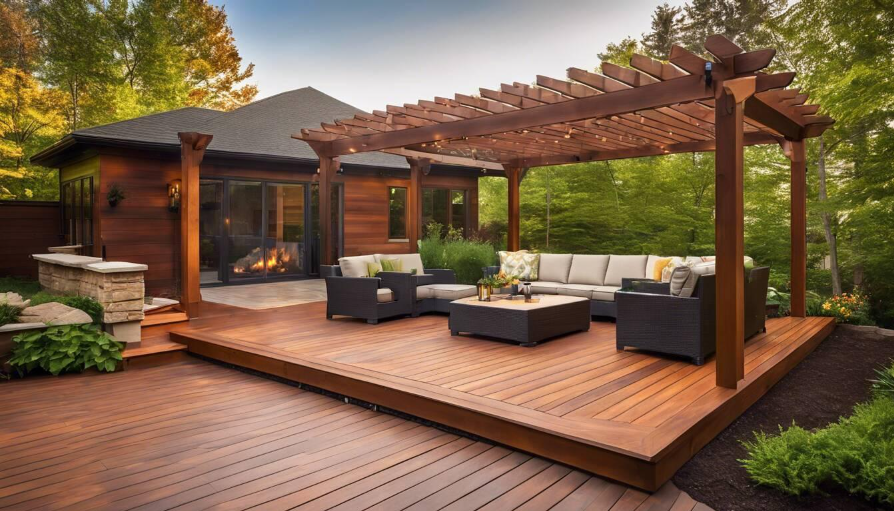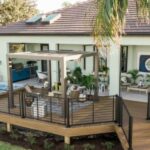Securely constructing a deck in Wisconsin calls for a blend of local expertise and precise familiarity with the state specific requirements. This starts with engaging a local decking builder renowned for exceptional craftsmanship and deep-seated knowledge of Wisconsin’s diverse climate conditions. But what you may not anticipate is that these contractors also provide critical insights into unique local building codes, guiding you even beyond the deck building process. As your journey begins, don’t forget about the stake of selecting your contractor.
When building a deck in Wisconsin, it’s crucial to consider the impact of seasonal weather changes, including snow, ice, and temperature variations. Utilizing durable, weather-resistant materials and proper reinforcement techniques will ensure the longevity and structural integrity of your deck in the Wisconsin climate. Whether you’re dreaming of lazy summer evenings or lively gatherings with friends, Excel Custom Deck’s expert insights, invaluable tips, and inspiring design ideas are here to turn your vision into reality.
Securing a Professional Deck Contractor in Wisconsin
When it comes to turning your dream deck into a reality, finding the right contractor is crucial. Let’s delve deeper into practical steps you should take to ensure you’re partnering with a reputable and skilled deck builder in the Wisconsin area.
Researching Local Contractors: Building for Wisconsin’s Climate
Firstly, dive into finding local contractors well-versed in crafting decks to withstand Wisconsin’s unique climate and environmental conditions. Seek out builders with strong reputations and extensive experience in tackling the challenges posed by the region’s weather patterns. Local expertise ensures your deck is resilient across Wisconsin’s diverse seasons.
Verifying Contractor Credentials: A Crucial Step
Next, ensure prospective contractors are licensed and insured, safeguarding both parties in case of accidents or unforeseen issues. Tap into customer reviews on platforms like Angie’s List or Yelp to glean insights into reliability and satisfaction. Glowing testimonials speak volumes about a contractor’s professionalism and commitment to quality.
Key Points:
- Licensed and Insured: Mutual protection for you and the contractor
- Customer Reviews: Gauge reliability and satisfaction levels
- Assessing Previous Work: Quality Speaks Volumes
Request project portfolios from potential contractors to assess their past deck projects. Evaluating samples provides first hand insights into workmanship quality and design compatibility with your vision. Consistent excellence in past projects indicates reliability and skill.
Inquire About:
- Quality of Workmanship
- Design Style Compatibility
- Cost to build a deck
- Gaining Inspiration: Exploring Past Projects
Seek design inspiration from contractors’ previous work, shaping your vision for your deck. Ensure their aesthetics align with your preferences, fostering confidence in their ability to bring your outdoor space dreams to life.
Consultations and Estimates: Transparency Matters
Ensure contractors offer free consultations and detailed estimates. Free consultations demonstrate a willingness to understand your needs, while detailed estimates provide clarity on costs and project scope.
Key Considerations:
- Free Consultations: Demonstrates collaboration and understanding
- Detailed Estimates: Transparent project costs and scope
- Tailored Services for Wisconsin: Expertise at Your Doorstep
Explore our website for deck building services crafted specifically for Wisconsin homeowners. Benefit from our deep understanding of local conditions and commitment to exceptional outdoor living spaces.
With these strategies, secure a professional deck contractor ready to create your dream outdoor oasis, perfectly tailored for Wisconsin living. Now, let’s delve into selecting optimal deck materials suited for Wisconsin’s diverse conditions.
Selecting Optimal Deck Materials in Wisconsin
When building or renovating your deck in Wisconsin, choosing the right materials is crucial due to the state’s varying weather conditions. With cold winters and hot, humid summers, it’s essential to consider materials that can withstand these climate fluctuations. Here are some key considerations when selecting deck materials:
Weather-Resistant Materials
It’s vital to opt for materials that can withstand the temperature swings, moisture, and heavy snowfall experienced in Wisconsin. For this reason, pressure-treated lumber, cedar, and composite decking materials are excellent choices. Pressure-treated lumber offers durability and resistance to rot and insect damage. Cedar has natural water-resistant properties and adds a touch of beauty to your deck. Similarly, composite decking materials provide great durability with minimal maintenance requirements.
Sustainable and Eco-Friendly Options
If eco-friendliness is a priority for you, consider exploring decking materials that are environmentally sustainable. Recycled composites and sustainably sourced wood are excellent choices for eco-conscious homeowners. Recycled composites utilize reclaimed plastics and wood fibers, providing a long-lasting and low-maintenance decking solution while promoting environmental sustainability. On the other hand, sustainably sourced wood ensures that the impact on natural forests is minimized, offering a renewable and eco-friendly decking option. Excel Custom Decks recommends Azek Timbertech and Fiberon Decking for sustainable decking options.
Low-Maintenance Choices
Wisconsin’s climate can take a toll on outdoor structures, so it’s essential to choose materials that require minimal upkeep and are resistant to rot, decay, and insect damage. Composite decking and PVC (polyvinyl chloride) decking are popular low-maintenance options that offer long-term durability without the need for extensive care.
By considering these factors when selecting deck materials for your Wisconsin home, you can ensure that your deck remains resilient in the face of the state’s diverse climate while aligning with your sustainability goals and maintenance preferences.
With the right materials in mind, let’s delve into the essential design elements that contribute to creating a stunning and durable deck for your Wisconsin home.
Essential Design Elements for Deck Construction
So, you’re set to build your dream deck in Wisconsin. Whether it’s for family cookouts, late-night stargazing, or simply soaking up the sun, there are a few key deck design elements to keep in mind to ensure you get the most out of your investment. Let’s start by ensuring that the layout is as functional and practical as it is beautiful.
Functional Layout
The deck’s layout is akin to the blueprint of a well-thought-out plan. It should take into account various elements such as seating areas, dining spaces, and outdoor cooking facilities. When crafting your deck’s design, think about how you will utilize the space and cater specifically to those activities. You’ll also want to ensure there’s enough room for everyone to feel comfortable and move around without bumping into each other. Moreover, having a clear pathway from the house to the yard or garden is vital for easy access.
Safety Considerations
Safety is paramount when it comes to deck building. Incorporating safety features such as railings, proper lighting, and non-slip surfaces is crucial, especially in regions where snow or rain can create slippery conditions. A well-designed and constructed railing not only enhances safety but also adds aesthetic value and defines the deck space. As for lighting, it’s not just about aesthetics—it also ensures visibility during twilight hours and provides a warm ambiance. Furthermore, non-slip surfaces help prevent accidents, making your deck accessible and safe for everyone.
Additionally, if your deck is raised or at an elevated level from the ground, incorporating integrated lighting into the stairways not only adds an elegant touch but also ensures visibility after dark, reducing the risk of tripping or falling.
Harmonizing with Surroundings
Your deck should harmonize with its surroundings—complementing the architectural style of your home, landscape features, and the natural beauty of the Wisconsin environment. This means carefully selecting materials, colors, and finishes that blend seamlessly with the existing aesthetics. Crafting a design that resonates with your environment creates a sense of unity and enhances the overall visual appeal of your property.
By carefully considering these essential design elements during deck building, you can ensure that your deck not only serves its functional purpose but also becomes a stunning extension of your living space—a place where fond memories are created and cherished for years to come.
As you embark on this exciting journey of creating your own slice of outdoor paradise in Wisconsin, it’s imperative to have an informed understanding of budget preparation for your upcoming deck project.
Preparing the Budget for Your Wisconsin Deck
Creating a budget for your deck building project is a sensible and crucial step that requires careful consideration of various factors. It’s essential to break down the anticipated costs into specific categories to get an accurate idea of the financial scope.
Material Costs
The choice of decking material significantly impacts the overall budget. Different materials vary in terms of initial costs, durability, and maintenance requirements. Wood may provide a traditional aesthetic but requires regular maintenance to prevent decay, while composite materials offer a low-maintenance alternative. Requesting price quotes from reputable suppliers will enable you to compare these aspects and make an informed decision about the most suitable material for your deck.
Labor Expenses
Incorporating labor expenses into your budget is non-negotiable. Hiring professional deck builders in Wisconsin entails costs that extend beyond their service fees. This includes any necessary permits and inspection fees mandated by local authorities. Factor these additional expenses into your budget to ensure comprehensive financial planning and avoid unexpected financial burdens during the deck building process.
Moreover, consulting with experienced deck builders can provide valuable insights into regional regulations and permit requirements, helping you anticipate and account for these expenses.
Contingency Funds
While outlining your budget, it’s essential to allocate funds for unforeseen expenses or potential design changes that may arise during the deck construction process. Setting aside a portion of your budget as contingency funds serves as a financial safety net, ensuring that unexpected costs do not disrupt the project’s progress or compromise its quality. These funds act as a safeguard against unforeseen challenges, offering peace of mind throughout the construction phase.
By meticulously preparing your budget and accounting for material costs, labor expenses, and contingency funds, you ensure thorough financial planning that sets the stage for a streamlined and successful deck construction process.
Adhering to Wisconsin’s Building Codes
When building a deck in Wisconsin, familiarizing yourself with the specific regulations and requirements set forth by the state and local building departments is essential. These regulations cover important aspects such as setbacks, load-bearing requirements, and safety codes that must be strictly adhered to during the construction process.
Wisconsin’s building codes are in place to ensure that all structures, including decks, are safe and built to certain standards. They dictate not only the structural integrity but also other parameters such as materials used, dimensions, and design. Additionally, these regulations safeguard against subpar deck building practices to ensure that decks are not only aesthetically pleasing but also safe for use.
For example, setback regulations determine how close the deck can be built to property lines or other structures. Load-bearing requirements specify the amount of weight that a deck can support. These regulations take into account local climate conditions and geological factors to ensure that your deck can withstand environmental stress over time.
Before you start any construction work, it’s crucial to make sure you have all the necessary permits in place.
Obtaining Necessary Permits
Building permits are required for new construction, remodeling, or making changes to existing structures. For deck construction in Wisconsin, obtaining the necessary permits is absolutely essential to avoid potential legal issues and ensure compliance with building codes. These permits serve as official consent from the local building department for the construction of your deck. They signify that your planned construction meets local zoning laws and building codes, ensuring that your deck is structurally sound and safe for use.
By obtaining permits before commencing any deck building work, you demonstrate your commitment to building a deck that complies with safety standards and legal requirements. This not only ensures peace of mind for you as the homeowner but also protects future homebuyers who will appreciate knowing that all required approvals were obtained.
Consider a deck without proper permits being discovered during a home inspection when you decide to sell your house in the future. This oversight could lead to regulatory complications or even require costly modifications to bring the deck up to code before concluding the sale.
Adhering to Wisconsin’s building codes and obtaining necessary permits not only ensures compliance with legal requirements but also guarantees the safety, integrity, and long-term enjoyment of your newly constructed deck. It’s an important step towards creating a space that is both beautiful and secure for your family and guests.
Now equipped with an understanding of how to adhere to building codes and obtain permits for your deck construction project, let’s move on to explore how you can ensure quality and durability of your Wisconsin deck.
Ensuring Quality and Durability of Your Wisconsin Deck
Your deck is going to be a critical part of your home. It’s where you’ll host barbecues, enjoy family time, and relax outdoors. That’s why it’s crucial that your deck is built to last through all kinds of weather and situations that Wisconsin might throw at it. Here are some important factors you need to consider to ensure the quality and durability of your Wisconsin deck.
Choosing the Right Materials
Materials play a significant role in the quality and durability of your deck, especially in a place like Wisconsin that experiences diverse weather conditions. For instance, cedar and composite decking are particularly popular in Wisconsin due to their sustainability and resistance to harsh weather. These materials offer great protection against snow loads, UV rays, and moisture. Cedar, for instance, is a great choice due to its natural resistance to decay and insect infestation. Whereas composite decking is highly durable and requires minimal maintenance, making it perfect for those cold winter months when outdoor tasks are less appealing.
The construction of the deck is just as crucial. Steel framing, despite being more expensive than wood, provides exceptional strength and durability, especially during heavy snowfall. The steel is resistant to warping and rotting, providing excellent structural reliability.
Seasonal Considerations
Considering the seasonal changes in Wisconsin is essential when planning for the longevity of your deck. Incorporating proper design elements such as sufficient drainage, durable finishes, and regular sealing can help your deck endure temperature fluctuations and heavy snow loads.For example, allowing adequate ventilation beneath the deck, especially during winter months, prevents snow accumulation, ice damage, and potential rot.
Choosing materials and construction methods that account for Wisconsin’s seasonal changes will ensure that your deck maintains its integrity through sun, rain, sleet, or snow.
Regular Maintenance
Just like any other aspect of your home, regular maintenance is key to ensuring your deck’s long-term structural integrity and aesthetic appeal in the face of varying weather in Wisconsin. Proper care includes sealing, cleaning, and inspecting regularly.
- Sealing: This is essential for wooden decks to keep them protected from moisture damage and harsh UV rays during the summer months. For composite decking too, regular sealing helps maintain its luster and resilience.
- Cleaning: Routine cleaning is crucial to prevent mold growth and grime buildup. Proper cleaning habits ensure your deck remains visually appealing throughout every season.
- Inspections: Regular inspections help identify early signs of wear such as loose boards or rusting metal connectors. Addressing these issues promptly prevents them from escalating into significant problems.
Taking these steps now makes it easier to maintain your deck so you can continue enjoying its benefits for many years to come.
Ultimately, choosing the right materials, understanding seasonal considerations, and keeping up with regular maintenance are all crucial components in ensuring the long-lasting quality and durability of your Wisconsin deck that will stand strong in all seasons.
For expert insights on designing a top-quality deck that withstands the changing seasons in Wisconsin contact Excel Custom Decks today by visiting Excel Custom Decks. Simply call: (414) 333-1888.
Frequently Asked Questions
What are some common mistakes to avoid when building a deck in Wisconsin?
Some common mistakes to avoid when building a deck in Wisconsin include failing to obtain the required building permits, neglecting proper foundation and support structures for the deck, using inferior quality or untreated lumber that is not suitable for Wisconsin’s fluctuating climate, and overlooking proper waterproofing and sealing techniques.
What are the specific building codes and regulations for deck construction in Wisconsin?
The specific building codes and regulations for deck construction in Wisconsin are outlined in the Wisconsin Uniform Dwelling Code (UDC) as well as local city or county ordinances. These regulations cover various aspects such as minimum deck location setbacks, required railing heights, maximum load capacities, and footing requirements. It is important for homeowners to consult their local building department for specific guidelines as they may vary slightly depending on the jurisdiction.
Are there any unique considerations or challenges when building a deck in Wisconsin compared to other states?
In Wisconsin, building a deck comes with unique considerations and challenges due to its climate. The state experiences harsh winters with heavy snowfall, which can impact the durability of the deck. This means that using appropriate materials and designing for snow load is essential to ensure the deck withstands the winter weather. Moreover, Wisconsin has a higher average annual precipitation compared to many other states, necessitating proper drainage solutions during deck construction.
Are there any specific materials or designs that are recommended for decks in Wisconsin’s climate?
Yes, there are specific materials and designs that are recommended for decks in Wisconsin’s climate. Due to the extreme temperatures and high levels of moisture throughout the year, it is advisable to use materials that can withstand these conditions. Pressure-treated wood, composite decking, and PVC decking are popular choices as they are durable and resistant to rot, decay, and warping. Additionally, incorporating proper drainage systems and considering designs that allow for snow removal easily can help prolong the lifespan of the deck. Statistics show that using appropriate materials and designs can significantly reduce maintenance costs and increase the longevity of decks in Wisconsin’s climate.
How can I properly prepare my land and foundation for building a deck in Wisconsin?
To properly prepare your land and foundation for building a deck in Wisconsin, start by surveying your property to determine the best location. Ensure you have obtained any necessary permits and abide by local building codes. Clear the area of vegetation, rocks, and debris, and then excavate the soil to a depth of at least 6 inches for adequate footings. Use a compactor to pack the soil, creating a stable base. It is also recommended to use concrete footings with embedded metal brackets for added stability, especially considering Wisconsin’s extreme weather conditions with heavy snow loads.





